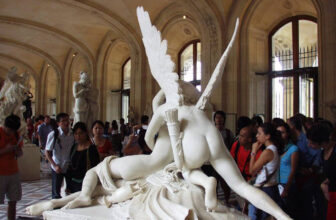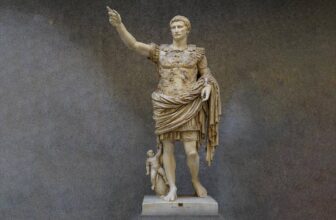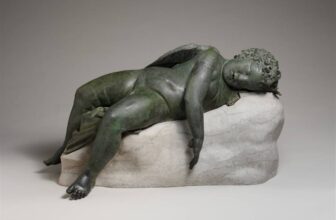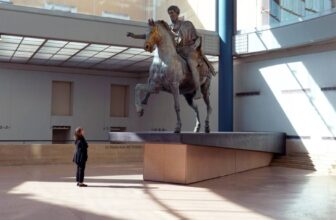
The Meaning Behind Antony Gormley’s Sculptures
Antony Gormley, a name synonymous with contemporary sculpture, has transformed the way we perceive the human form in space. Known for his thought-provoking and often monumental artworks, Gormley’s sculptures are not only feats of engineering and artistry but are also vessels of deep philosophical inquiry. With works that span the globe, from the desolate sands of English beaches to the rooftops of skyscrapers, Gormley has managed to carve a legacy rooted in the dialogue between the body, space, and time.
In this comprehensive story, we’ll journey through the world of Antony Gormley: exploring how he creates his sculptures, the meanings they embody, his most iconic works, their value in the art market, and the various locations around the world where his works stand sentinel. This is not just a biography, it’s a deep dive into the mind of a man who has helped redefine the relationship between art and humanity.
Who Is Antony Gormley? A Brief Background
Born in London in 1950, Sir Antony Mark David Gormley grew up in a devout Roman Catholic household. His early education in theology, archaeology, and art history at Trinity College, Cambridge, deeply influenced his artistic sensibilities. Following extensive travels in India and Sri Lanka, where he explored Buddhism and Eastern philosophies, Gormley returned to the UK and studied at the Central School of Art, Goldsmiths College, and the Slade School of Fine Art.
His exposure to both Western and Eastern philosophies profoundly shaped his outlook on art, leading him to develop a sculptural language that bridges spirituality, human form, and the collective experience of being.
How Antony Gormley Creates His Sculptures
Antony Gormley’s approach to sculpture is deeply rooted in the physical experience of the body, specifically his own. For decades, his body has served as the foundational template for his work. Using various casting techniques, Gormley creates molds of himself, which then become the basis for many of his sculptures.
Step-by-step process:
Body Casting:
The process typically begins with Gormley being covered in a material like plaster or wrapping bandages soaked in resin to create a body mold. This can take hours, with him breathing through straws and remaining immobile.Mold Creation:
Once the mold is removed, it is used to produce a positive cast, often in wax or clay. This interim form helps refine the pose and allows adjustments before moving on to the final material.Material Transformation:
The sculpture is then cast in a durable material such as iron, steel, or lead. For many of his iconic works like Angel of the North and Another Place, weathering steel (also known as COR-TEN) is used to create a rusty, enduring surface that integrates with its environment.Industrial Collaboration:
Gormley works closely with engineers, foundries, and metal fabricators to realize his large-scale projects. The technical aspects, like structural stability, corrosion resistance, and anchoring, are as crucial as the conceptual underpinnings.Site-specific Considerations:
The location of each sculpture plays a key role. Whether a piece stands in solitude on a beach or hovers among city skyscrapers, Gormley considers geography, history, and social context when choosing where to place his work.
The Meaning Behind Antony Gormley’s Sculptures
Gormley’s sculptures are less about representation and more about presence. They rarely show expression, gender, or detail. Instead, they act as archetypes, everyman figures standing in for all of us. His work revolves around several recurring themes:
The Body as Space:
Rather than portraying the body as an object, Gormley treats it as a place, a site of consciousness. His figures are not simply anatomical; they evoke the internal landscape of emotion, sensation, and thought.
Isolation and Connection:
Many of his installations involve multiple figures, each alone, yet part of a collective experience. This duality reflects the human condition: our inherent solitude, counterbalanced by a longing for connection.
Time and Permanence:
Sculptures like Angel of the North and Another Place evolve over time. Subject to weather, tides, and public interaction, these works engage with natural cycles and human impermanence.
The Viewer as Participant:
Gormley’s works often invite physical and emotional engagement. In projects like Inside Australia or Field, the viewer becomes part of the installation, blurring the line between observer and observed.
Spirituality Without Dogma:
Although influenced by religious iconography and philosophy, Gormley’s work transcends specific faiths. His sculptures invite meditation and introspection rather than offering doctrinal answers.
Antony Gormley’s Most Famous Art Sculpture: Angel of the North
Arguably, the most iconic of all Gormley’s works is the monumental Angel of the North.
Overview:
Location: Gateshead, Northern England
Height: 20 meters (66 feet)
Wingspan: 54 meters (177 feet) , wider than a Boeing 757
Material: Weathering steel
Installed: 1998
The Angel of the North stands on a hill overlooking the A1 motorway and is seen by over 33 million people annually. It has become one of the most recognized public artworks in the UK and a symbol of Northern identity and resilience.
Symbolism:
Industrial Heritage: Made of steel, it references the region’s mining and steelwork history.
Spiritual Comfort: With outstretched wings, it evokes protection and welcome.
Human Connection: The angel form, modeled on Gormley’s own body, acts as a bridge between earth and sky, humanity and the divine.
What Are Antony Gormley’s Art Sculptures Worth?
Gormley’s artworks command significant value in the international art market. While many of his large public commissions are priceless due to their scale and cultural impact, individual sculptures sold through galleries or auctions can fetch high prices.
Market Highlights:
Smaller cast iron or lead sculptures of his body form often range from £100,000 to £500,000.
His “blockworks” (e.g., Big Thinking, Rest, Contract) can sell for £500,000 to £2 million, depending on size and material.
Major gallery installations or limited series works have sold for £2 million and above.
As of 2025, Gormley is considered one of the UK’s wealthiest living artists, with an estimated net worth of over £30 million, largely driven by public commissions, global exhibitions, and collector demand.
Where Can You Find Antony Gormley’s Art Sculptures?
Gormley’s works span continents, existing both indoors in museum spaces and outdoors in public realms. Here are some of the most renowned locations where you can experience his work:
United Kingdom
Angel of the North – Gateshead, England
Another Place – Crosby Beach, Liverpool (100 life-size iron men spread over 2 miles of shoreline)
Event Horizon – London rooftops (also exhibited in NYC and Hong Kong)
Inside – Royal Academy, London
Europe
Horizon Field – Vorarlberg, Austria (100 life-size cast iron figures placed at 2,000m elevation across the Alps)
Quantum Cloud – O2 Arena, London (on the Thames, originally for Millennium Dome)
Exposure – Lelystad, Netherlands (26-meter-tall crouching figure made of 5,400 steel bars)
North America
Event Horizon – New York City (2010) – 31 life-sized figures on rooftops in Manhattan
Learning to See – Multiple galleries and museum installations across the U.S., including MoMA and the Nasher Sculpture Center
Asia
Asian Field – Guangzhou, China (thousands of clay figures made with local volunteers)
Singapore Biennale – Displayed figures in urban and green spaces
Australia
Inside Australia – Lake Ballard, Western Australia (51 sculptures across a salt lake desert)
Gormley in Public Consciousness and Legacy
Antony Gormley’s art has not only transformed physical spaces but also challenged how people engage with their environments and themselves. His use of the human form as a universal symbol has made his work accessible and resonant, transcending cultural and linguistic barriers.
He has received numerous awards, including:
Turner Prize (1994)
Knighted in 2014 for services to the arts
Honorary Fellowships at leading art institutions
More than accolades, though, Gormley’s lasting contribution is his ability to evoke presence in absence. His figures, silent, still, faceless, speak volumes about our shared condition as embodied, conscious beings navigating space, time, and memory.
Antony Gormley is far more than a sculptor. He is a philosopher of form, a chronicler of consciousness, and a creator of monumental meditations. From the rusting bodies of Another Place to the awe-inspiring wings of Angel of the North, Gormley’s sculptures ask us to pause, reflect, and feel what it means to be alive in a particular place, in a particular body, at a particular moment.
Whether you stumble across his figures in a windswept field or a bustling city, the experience is always the same: a profound encounter with the universal human spirit, grounded in iron, and yet reaching for the infinite.




